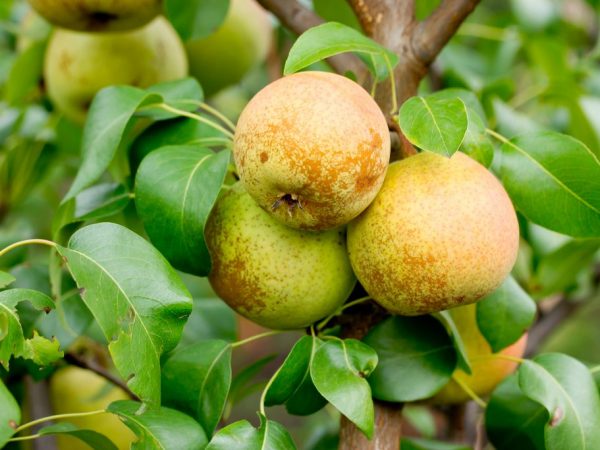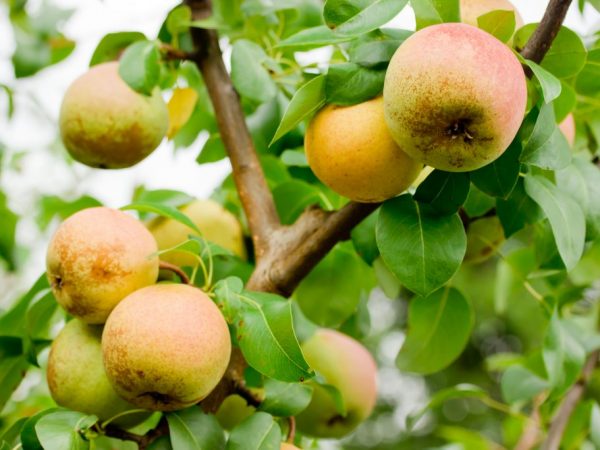Characteristics of the Powislaya pear variety
One of the brightest representatives of ornamental and fruit crops is the Powislaya pear. This is a special selection, it has all the qualities of a primordial and hybrid tree. We will consider a detailed description of the variety in the article.

Characteristics of the Powislaya pear variety
Characteristic
The Powislaya pear variety belongs to the dicotyledonous, flowering, pink-flowered order. Deciduous tree.
The variety is obtained by crossing the Usurian and Olivier de Serre pears. The features include a characteristic crunch when biting and average winter hardiness. According to the description, fruiting begins after 4-5 years. The yield is increasing rapidly.
Description of the tree
Outwardly, the Pear variety can be characterized as follows:
- medium-sized tree;
- slow growing;
- the crown is sparse and drooping.
The fruits are located on the ringlets or at the ends of the shoots. The leaves are pointed and glossy. Their color is light green, the veins are thick and coarse. The variety is characterized by a peculiar bark - flaky and greenish-brown.
Description of fruits
This variety has small fruits, weighing 50-90 g. Their color is greenish. The shape is oval. With good maturation, a reddish blush appears in the color. Description of fruits: very tasty, with juicy and sweetish-sour pulp.
Fruits ripen in September. They are not stored for long, until the first decade of November. The fruits are characterized by average winter hardiness.
You can eat it fresh or cook compotes, dried fruits.
Growing pears
Before disembarking, you should decide on the landing site. Carefully prepare the planting pit. In order for the tree to take root well, one- or two-year-old seedlings should be taken.
Their root system should be well developed, without damage. The above-ground part of the tree should not have breaks or unnecessary cuts.

Delicious pear
Landing in the soil
Pear trees are planted in spring or autumn. But this variety is best planted in September, when it is no longer hot. At this time, the seedlings usually have fallen leaves and there is no rapid sap flow.
The soil is preliminarily prepared. If it is sour, you need to make lime. The best landing site would be a sunny and wind-protected area.
A hole is dug to a depth of 70-80 cm and up to 1 m wide. A rod or stake must be inserted into the center in order to further help the tree grow in the desired direction.
For better growth, the following fertilizers should be applied to the pit:
- rotted manure 8-10 kg (can be replaced with compost);
- superphosphate 50g;
- potassium salt 30g.
Mix this with earth and spread evenly over the entire bottom of the pit. After that, the seedling is set and covered with earth gradually. The root collar should remain above the ground at a height of 4-8 cm.
At the end of planting, compact the earth and water abundantly. Tie the trunk to a previously driven peg or twig and mulch around with manure or humus. It is necessary to pay attention that this mulch in no case touches the trunk of the seedling.
Plant care
Young seedlings are especially in need of care. They should be watered regularly, especially during dry season. The calculation of watering is very simple, at least 1 bucket of water per week.
For the winter, the hanging pear variety should be covered. This will save them from severe frosts and winds. And in early spring, remove the covering material and take preventive measures against diseases.
Fertilization
Fertilization is very important for a healthy and bountiful harvest. Feeding with nitrogen-containing substances for the first 4 years is done several times per season. Potash fertilizers are applied only once a year.
It is good to do this in spring and autumn when loosening the soil around the trunk. During spring flowering, top dressing should include urea, saltpeter, and chicken droppings.
Recipe: take 30g of nitrate per 1 sq. m., diluted in water (proportion 1:50) and water the near-trunk circle. If there is urea, then dilute 100-120 g (per 1 tree) in 5 liters of water and water.
After flowering, green fertilizer can be applied to make the fruits juicy and tasty. This is done for digging 8-10 cm. This event contributes to the saturation of the plant with organic matter. Vegetation is intensifying.
In May, you can fertilize with nitroammophos in a ratio of 1: 200 with water. Pour 3 buckets of mortar under one tree.
In the summer, there are many trace elements in the soil. Therefore, the feed is different from the spring feed. It is good during this period to fertilize through the leaves, i.e. carry out foliar feeding. By the middle of the summer season, phosphorus and potassium are introduced into the soil, alternating with mineral and nitrogen fertilizers every 2 weeks. The frequency of feeding is regulated by their external observations of the plant.
With the onset of the autumn period, phosphorus fertilizers are also introduced. Feeding the plant before the cold weather is a very important stage. The amount of fertilizer is selected according to the degree of tree growth and the size of the trunk circle. It is good during this period to add wood ash (150g per 1 sq. M), to a depth of 8-10 cm.
After 5 years of pear life on the site, all fertilizers should be applied to the peripheral zone of the crown, having previously made special grooves.
Watering pears
Watering is carried out at least once a week. Visually, this can be determined by the dryness of the soil around the tree. If there was little rain in the spring, you should water more often and more abundantly. A clear watering rate should be observed: 2-3 buckets for each year of life.
Diseases and pests
This pear variety is quite disease resistant. But sometimes they can appear if the rules of cultivation and preventive measures are not followed. Bad weather can also contribute to this.
Pear diseases include:
- scab - appears on the trunk, young branches and leaves;
- stem rot is burns from frost or sun, it appears even with a lack of nutrition;
- powdery mildew is a fungal disease. The symptom of the disease is white bloom.
Pest control
Several types of pests can infect a pear: pear honeydew and pear moth. When they appear, they must immediately be treated with colloidal sulfur, insecticides or Bordeaux liquid.
Prophylaxis
For prevention, tree pruning should be carried out in a timely manner. Visual inspection will help identify the appearance of the pest and prevent their reproduction. Affected branches and foliage must be completely burned to prevent residues from entering the compost pit.
Conclusion
Growing a hanging pear will not be difficult if you follow the rules of care. Timely feeding and prevention of the tree will allow you to get a rich harvest of large and tasty pears.


